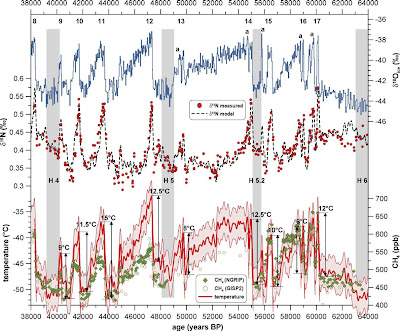Increased atmospheric co2 leads to decreased output of methane from biomass due to reduced water uptake. Co2 cools.
A Pictorial of biomass' effort to be warm;

Oldest to newest.

Newest to oldest. Ice core data.
http://www.climate.unibe.ch/~spahni/papers/huber06epsl_b.pdf

Oldest to newest.



Oldest to newest. Any temperature below 22 deg C can be said to fall within natural variation.

Oldest to newest. Any co2 concentration under 2000ppm can be said to be within natural variation. 180m years ago the climatologists must have been apoplectic, these days they are merely apocalyptic.
This image obviously proves co2 drives temperature. To proponents. The rest of us lean more to rationality.
| Central England Average Temperatures (°C) | JAN | FEB | MAR | APR | MAY | JUN | JUL | AUG | SEP | OCT | NOV | DEC | Annual |
| 1961 to 1990 | 3.8 | 3.8 | 5.7 | 7.9 | 11.2 | 14.2 | 16.1 | 15.8 | 13.6 | 10.6 | 6.6 | 4.7 | 9.5 |
| 1880 to 2004 | 3.8 | 4.1 | 5.7 | 8.0 | 11.3 | 14.2 | 16.1 | 15.7 | 13.5 | 10.0 | 6.5 | 4.5 | 9.5 |
| 1659 to 2005 | 3.2 | 3.8 | 5.3 | 7.9 | 11.2 | 14.3 | 16.0 | 15.6 | 13.3 | 9.7 | 6.0 | 4.1 | 9.2 |


RSS MSU temperature anomaly for the lower troposphere (the layer near surface, description) in deg C, 1998-2007. And by rank below.





I would expect these spikes to correlate with ENSO events.
Expanding and contracting oceans. I wonder how much energy the oceans use accomplishing these volume adjustments?

Red is outgassing of co2 phase, blue is absorption phase.
We are in an absorption phase that is likely to last through summer. None this deep have ever lasted less than18 months and some lasted past 2 years. That should be making a dent in Mauna Loa co2 data that will take some really strong smoothing to make it conform to virtual reality. The phase is called La Nina. It is likely, in combination with airborne particulates (natural dust, pollution other than co2) reflecting sunlight to make 2008 cooler than 2007. Co2 continues to increase but it is a spent gas, no more warming from that quarter.
Refs. http://www.freerepublic.com/focus/f-news/1644060/posts
http://mysite.verizon.net/mhieb/WVFossils/Carboniferous_climate.html
http://motls.blogspot.com/2008/01/2007-warmest-year-on-record-coldest-in.html
http://www.junkscience.com/Greenhouse/index.html
http://www.junkscience.com/MSU_Temps/Warming_Look.html
http://www.scotese.com/climate.htm
http://www.nov55.com/clng.html
The net effect of shortening absorption distance by so-called greenhouse gases is more cooling than heating for near-surface temperatures.
